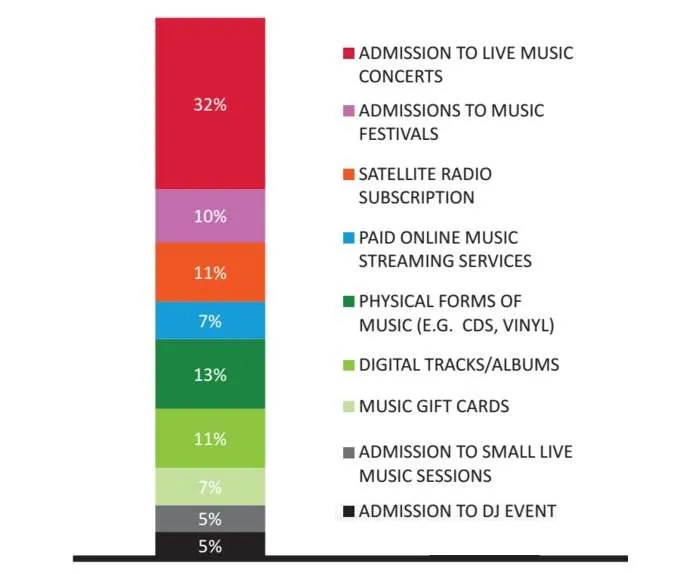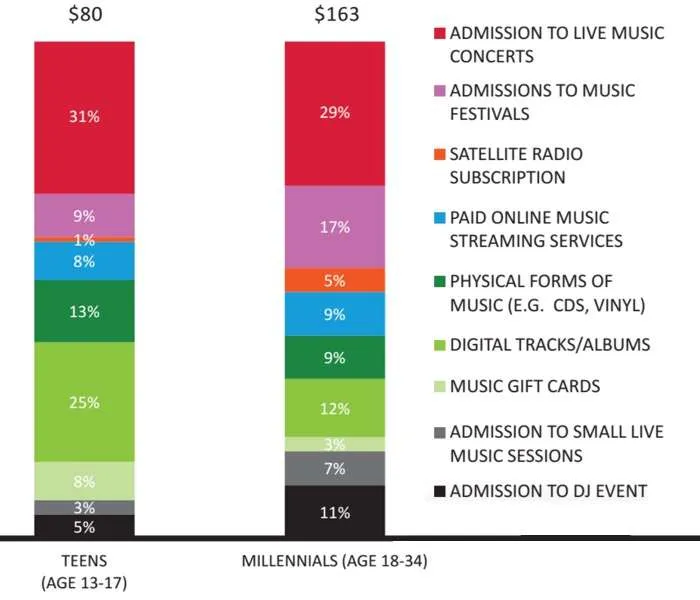How Much Money Do People Spend On Concerts Yearly
Question: In a typical twelvemonth, about how much money do you spend on the post-obit?

Source: Nielsen Music 360 US, 2015.
Concert tours used to support album releases. Now, there may not even be an album to sell.
According to just-released data from Nielsen, more than half of every dollar spent on music in the United states went to live events. The survey, conducted final year, showed a massive 52% of music-related consumer spending involved some sort of live effect, with festivals commanding a 10% slice. That said, smaller music sessions and DJ-driven events too claimed x%, function of a broader shift away from large, unmarried- or double-superstar artist bills.
Overall, Nielsen institute the average American music consumer spent $152 over the course of a twelvemonth.
All of that spells big money for a number of companies focused on alive events, including heavyweights similar Alive Nation and AEG Alive. Others similar Magnifi, Bandsintown, Songkick, and Jakprints are well-positioned confronting the trend, with analytics playing a far bigger role. But recently, Live Nation caused information-focused BigChampagne with seriously regrettable results, though despite the rapidly-shuttered 'Live Nation Labs,' data is definitely part of live music'due south future.
Glaringly absent from the survey were items like music trade, oftentimes purchased aslope expensive concessions and parking at gigs. Given the number of loftier-dollar add-ons at shows, it's likely that live music spending is actually higher. Separately, smaller, contained artists are gaining greater sensation of how to sell merch at gigs, thanks to startups similar AtVenu.
Also not counted are smaller, independently-contracted gigs through companies like GigSalad, a growing source of artist income.
Among younger buyers, some major differences announced between tweens and Millennials, largely because the latter group has more disposable greenbacks and far more freedom. That would explicate far college alive result attendance among Millennials, not to mention bigger overall spending on music.

Looking ahead, live concerts are likely to control an even larger chunk in 2016. Currently, 'digital tracks and albums' claimed 11 percent of total spending, though paid downloads are sinking fast. According to separate data released by Nielsen Music, paid downloads from outlets like iTunes and Amazon slumped 12.5 percentage last year, and 23.four percent since 2013.
Other non-live categories are as well sinking fast, peculiarly physical formats, thank you to continued bleeding around the CD. Indeed, vinyl is the celebrated success story, but full vinyl sales remain a small per centum of the hefty billions once generated by shiny discs.
And that brings us to ane of the biggest advantages of live gigs: scarcity. In the cease, a concert tin can't be instantly copied and duplicated, and neither can the social, in-person aspects that come up with information technology.
Source: https://www.digitalmusicnews.com/2016/01/08/one-third-of-all-music-spending-goes-to-live-events/
Posted by: elydenteenow1985.blogspot.com

0 Response to "How Much Money Do People Spend On Concerts Yearly"
Post a Comment